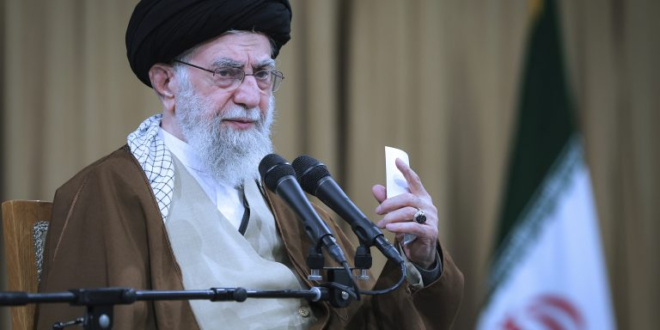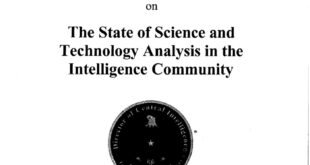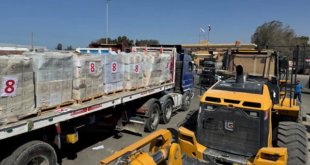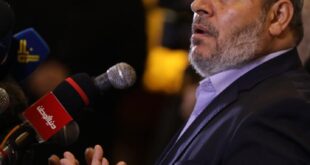Iran and the U.S. are moving toward nuclear negotiations, even as Trump builds up forces that could be used for military action against Iranian installations.
Responding to U.S. coercive diplomacy, including the buildup as well as maximum economic sanctions pressure, Iran has accepted new negotiations with the Trump team.
The pathway to a successful negotiation is complicated by entrenched “red lines” drawn by Tehran and Washington.
Iran is threatening regional bases used by U.S. forces, as well as U.S. regional allies, should Trump decide to use military action to stop Iran’s nuclear program.President Trump and his foreign policy aides are divided over how to address Iran’s advancing nuclear program. The issue has become progressively more acute – for the United States and particularly for Israel, which identifies Iran’s nuclear program as an “existential threat” – as Iran assembles the fissile material and knowledge it would need to produce a nuclear weapon. The International Atomic Energy Agency (IAEA) assesses Iran could, within days, produce enough weapons-grade uranium (90% purity) to fuel six nuclear weapons. Director of National Intelligence Tulsi Gabbard testified two weeks ago the U.S. intelligence community (IC) continues to assess Iran is not trying to produce an actual nuclear weapon, but it observes open discussion among Iranian leaders about repealing Supreme Leader Ali Khamenei’s politico-religious declaration against producing nuclear weaponry.
Some Trump aides want to negotiate a new and more sweeping nuclear agreement to replace the 2015 multilateral JCPOA, which Trump exited in 2018 during his first term, considering it too lenient. Other Trump officials judge talks with Iran as highly unlikely to produce an agreement and support major strikes on Iran’s nuclear facilities, whether unilateral by the U.S. or in concert with Israel. However, the policy decision is ultimately Trump’s to make, and, for now, he has decided to pursue a diplomatic pathway that would necessitate Iran’s complete dismantlement of its uranium enrichment program. The policy decision is consistent with the views of most proliferation experts who assert that military strikes on Iran’s nuclear facilities would only set back, not end, Iran’s capacity to produce a nuclear weapon eventually. One former U.S. defense official told journalists that a concerted, joint U.S. and Israel air campaign could seriously damage Iran’s nuclear facilities but would likely need to be repeated in nine months or a year if Tehran sought to rebuild the program. Israeli leaders express growing confidence that, even if Israel were to act independently, without U.S. backing, Israel could cripple Iran’s nuclear facilities.
In implementing his course of action, Trump confirmed in a March interview on Fox Business he had sent a letter to Khamenei proposing negotiations on a new agreement. He and his national security aides envision the agreement not only reimposing but also adding restrictions on Iran’s nuclear program, as well as mandating strict limits on Iran’s missile and drone programs and its support for regional armed factions that constitute its “Axis of Resistance.” Trump’s letter threatened Iran with serious adverse consequences (i.e., military action) if Tehran refused to negotiate or if no agreement is reached within two months (presumably from the time formal talks begin).
Khamenei’s initial public reaction seemed to categorically reject Trump’s overture, claiming Trump sought to coerce Iran’s capitulation through “bullying.” He also expressed distrust of new negotiations with a U.S. leader who had exited the original JCPOA, despite the IAEA’s assessment that Iran was in compliance with the accord, and instead imposed a sanctions-centric “maximum pressure” policy on Iran. Later, Iranian foreign policy officials softened the Supreme Leader’s comments, acknowledging Tehran was considering Trump’s offer to talk. Iranian officials advocating talks reportedly argued Iran needed an agreement with Trump to alleviate economic pressure on Tehran that was certain only to increase as Trump reinstated his maximum pressure strategy on the Islamic Republic. The Trump team has stated its core goal is to reduce Iran’s still significant sales of oil to China (approximately 1.5 million barrels per day). Last week, the Administration sanctioned a Chinese oil refinery in an effort to deter small Chinese oil traders from buying Iranian oil.
U.S. threats of military action, added to the reinstatement of the maximum pressure strategy, filled out the Trump attempt to use “coercive diplomacy” to bring Iran back to the negotiating table. In late March, the U.S. military redeployed major assets to bases near Iran, including six B-2 Stealth Bombers to the U.S. base on the Indian Ocean island of Diego Garcia. U.S. officials indicated the buildup was intended primarily to support Trump’s air campaign against Houthi militant targets in Yemen – part of his efforts to strategically weaken Iran and its Axis. However, Iranian officials interpreted the U.S. deployments – coupled with Trump’s threats of action if Iran refused talks on a new agreement – as preparation for an attack on Iran.
Iranian officials immediately sought to deter an attack. Former Iranian Majles (parliament) Speaker Ali Larijani, now a key adviser to the Supreme Leader, said in an interview: Iran will “move toward” a nuclear weapon in response to a U.S. or Israeli attack. Brig. Gen. Amir Ali Hajizadeh, the commander of the Islamic Revolutionary Guard Corps (IRGC) Aerospace force, which operates Iran’s missile arsenal, threatened to retaliate against bases in the Arab Gulf states where US military personnel and equipment are positioned, stating: “…when one sits in a glass house, one does not throw stones at others.” The Iranian threat seemed to intimidate the Gulf states, all of which have improved relations with Iran in recent years, reportedly prompting them to insist the U.S. not use their bases for a pre-emptive strike on Iran. Iranian officials also warned that, if attacked, they would exit the Nuclear Non-Proliferation Treaty (NPT), expel IAEA inspectors, and pursue a nuclear program covertly.
Despite Iran’s outward expressions of confidence it could withstand U.S. sanctions or even an attack, the U.S. coercive diplomacy might have shifted the debate in Tehran toward talks with Trump representatives. Media outlet Axios reported April 2 Trump officials received a formal Iranian response to the Trump letter, expressing agreement to indirect talks mediated by the Sultanate of Oman, but rejecting, at least initially, direct US-Iran negotiations. Trump officials did not reject the Iranian indirect format or Omani mediation, but Trump told reporters Thursday he would prefer direct talks, stating: “I think it goes faster, and you understand the other side a lot better, than if you go through intermediaries…I know for a fact that I think they would like to have direct talks.” Despite Iran’s relatively positive formal response, no negotiations have been announced, to date. However, some journalists report talks might begin before the end of April, possibly accompanied by mutual confidence-building measures such as Iran’s release of improperly detained U.S. or other Western citizens and possibly some modest U.S. sanctions relief. Oman’s potential mediation role, along with Trump’s transmission of his letter to Khamenei via UAE senior officials, suggests the Trump team will give the Gulf states a “seat at the table” in formulating a new agreement with Iran. Gulf leaders complained they were excluded from the multilateral talks leading to the original JCPOA in 2015.
Even as the U.S. and Iran edge toward talks, there is substantial doubt about whether a new deal with Iran is possible. Talks during the Biden Administration to restore the JCPOA failed despite two years of negotiations, in large part because Iran is demanding more extensive sanctions relief than it did in the original JCPOA. Trump’s position on sanctions relief is, if anything, less flexible. More directly, as clarified by National Security Adviser Michael Waltz on CBS’ “Face the Nation” last week, Trump will demand a complete dismantlement of Iran’s uranium enrichment program. Waltz stated Tehran must agree to “walk away completely” from its pursuit of nuclear weapons, adding: “This isn’t some kind of, you know, kind of tit-for-tat that we had under the Obama administration or Biden…This is the full program. Give it up or there will be consequences.” However, Iran has long rejected ending its enrichment of uranium, claiming it is a party in good standing to the NPT and has a “right” to enrich uranium. Articulating a stance likely to further hinder an accord, Trump officials assert Iran must agree to negotiate restrictions not only on its nuclear program but also on its long-range missile programs, its armed drones, and its support for its Axis of Resistance partners. Iran has repeatedly said it would never negotiate on its ballistic missile program, which it sees as vital to its defense and ability to deter Israel and other foes. Iran has ruled out restricting its support for its Axis of Resistance partners, insisting many powers are intervening in the region by supporting armed groups and Iran has a right to support non-state actors ideologically aligned with Iran’s views and policies.
 Eurasia Press & News
Eurasia Press & News




